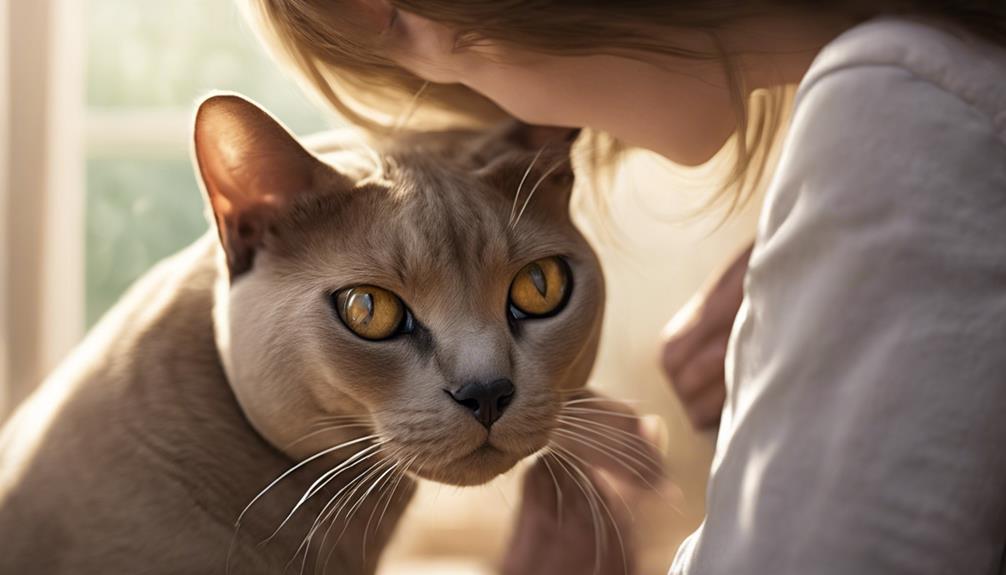When it comes to allergies, Burmese cats are considered relatively hypoallergenic due to their low shedding and minimal dander. Their lower shedding levels make them a good choice for those with pet dander sensitivity. While they do release the Fel d1 protein in saliva, their overall allergen exposure rating is moderate. Regular grooming with a rubber curry brush is key to managing shedding and reducing allergen exposure. With proper care and cleaning routines, owning a Burmese cat can be a great option for those prone to allergies. Discover more about hypoallergenic Burmese cats to make an informed decision.
Key Takeaways
- Burmese cats have low shedding and minimal dander, making them hypoallergenic.
- Their grooming routine helps reduce allergen exposure significantly.
- Regular grooming practices are crucial for managing allergies.
- Burmese cats are rated 8/10 on the hypoallergenic scale.
- Keeping their living areas clean supports their hypoallergenic nature.
Burmese Cat Allergy Considerations
Considering the allergy implications of owning a Burmese cat is crucial for individuals sensitive to pet dander. While no cat breed is entirely hypoallergenic, Burmese cats are known for their lower shedding levels, which can make them a better choice for allergy sufferers.
It's essential to note that cat hair itself isn't the main culprit for allergies; instead, it's the protein Fel d 1 that causes reactions in sensitive individuals. To manage allergies effectively, cat owners can implement regular cleaning routines, establish cat-free zones in the home, and utilize HEPA air purifiers to reduce dander levels.
These measures can help minimize allergic reactions and create a more comfortable environment for both the cat and its owners. Consulting with an allergist can also provide valuable insights on living with a cat while managing allergies, helping individuals determine if a Burmese cat is a suitable option for their specific sensitivities.
Shedding Levels in Burmese Cats
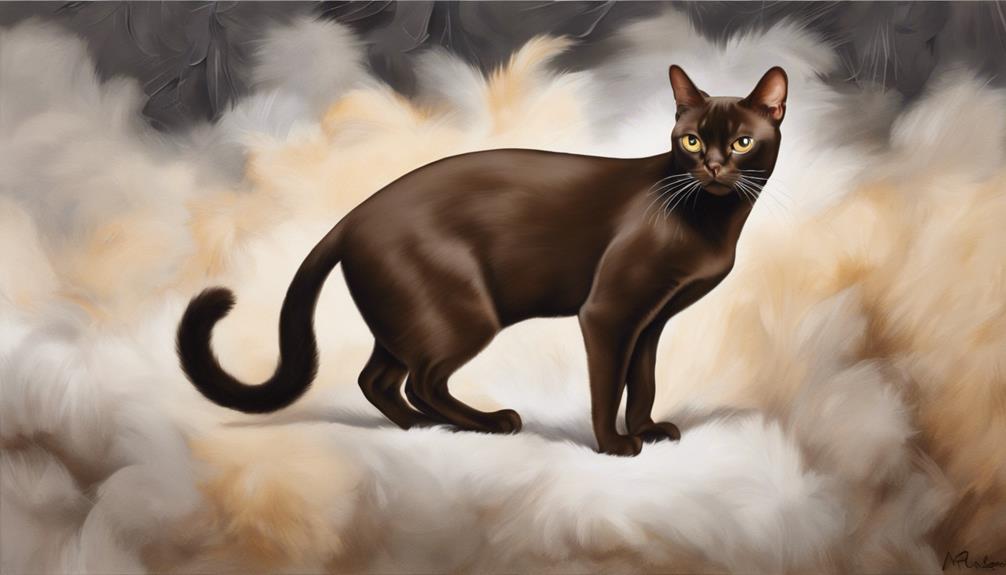
Burmese cats exhibit minimal shedding compared to many other breeds, with their shedding levels typically rated at 2/10. This low shedding is a key factor in their hypoallergenic nature, making them a great choice for individuals sensitive to allergens.
Monitoring your Burmese cat's shedding is essential, as any sudden increase could signal an underlying health concern that needs attention. Their fine, silky coat is relatively low maintenance, requiring only minimal grooming to keep it in top condition.
Regular brushing with a rubber curry brush not only helps manage shedding but also reduces allergen exposure, benefiting both you and your feline companion. By taking simple steps to care for your Burmese cat's coat, you can enjoy a cleaner home environment and fewer allergy triggers.
Burmese Cat Saliva and Dander
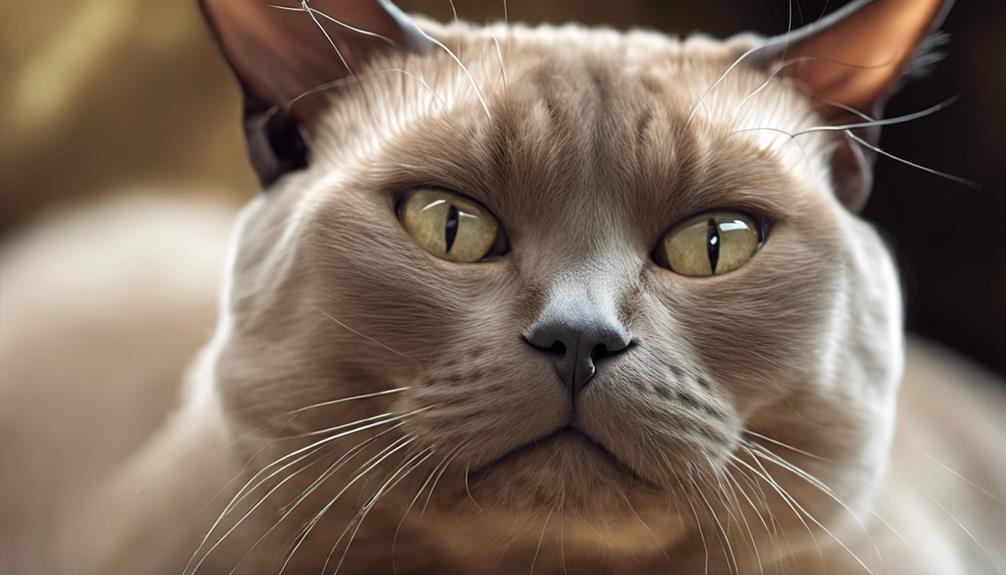
When assessing the allergen exposure potential of Burmese cats, their saliva and dander levels play crucial roles in determining sensitivity for individuals. Burmese cats are considered hypoallergenic due to their lower dander levels compared to many other breeds, which reduces allergen exposure. However, it's essential to note that they still release allergens, including the Fel d1 protein present in their saliva. The probability of saliva exposure from Burmese cats is rated at 4/10 for allergy concerns, while their dander levels are rated at 3/10, indicating a lower risk for allergy sufferers.
| Aspect | Rating |
|---|---|
| Saliva Exposure | 4/10 |
| Dander Levels | 3/10 |
| Allergen Exposure | Moderate |
| Fel d1 Presence | Yes |
| Allergy Concerns | Considerable |
Regular grooming practices can significantly help manage dander levels and reduce the potential for allergic reactions in sensitive individuals. By staying on top of grooming routines, you can create a more comfortable environment for both you and your Burmese cat.
Grooming Tips for Allergy Management
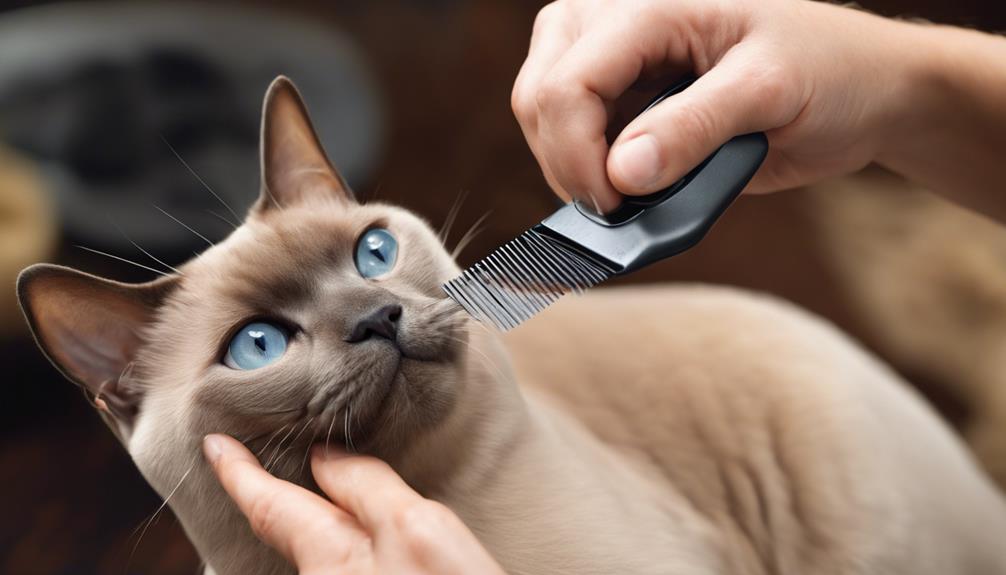
To effectively manage allergies, incorporating regular grooming practices into our routine is essential for keeping allergen levels low on our Burmese cat. Burmese cats are good for allergy management due to their low shedding and less dander production. By committing to weekly brushing sessions, we can help reduce allergens on our feline friend, making it easier for allergic individuals to coexist with them.
As responsible cat parents, it's crucial to understand that proper grooming not only benefits our Burmese cat but also contributes to managing allergies in our homes. The ease of grooming Burmese cats makes it a practical choice for those seeking hypoallergenic cat breeds. Additionally, the self-grooming habits of Burmese cats play a role in maintaining a clean coat and minimizing the spread of allergens in our living spaces.
Hypoallergenic Burmese Cat Care
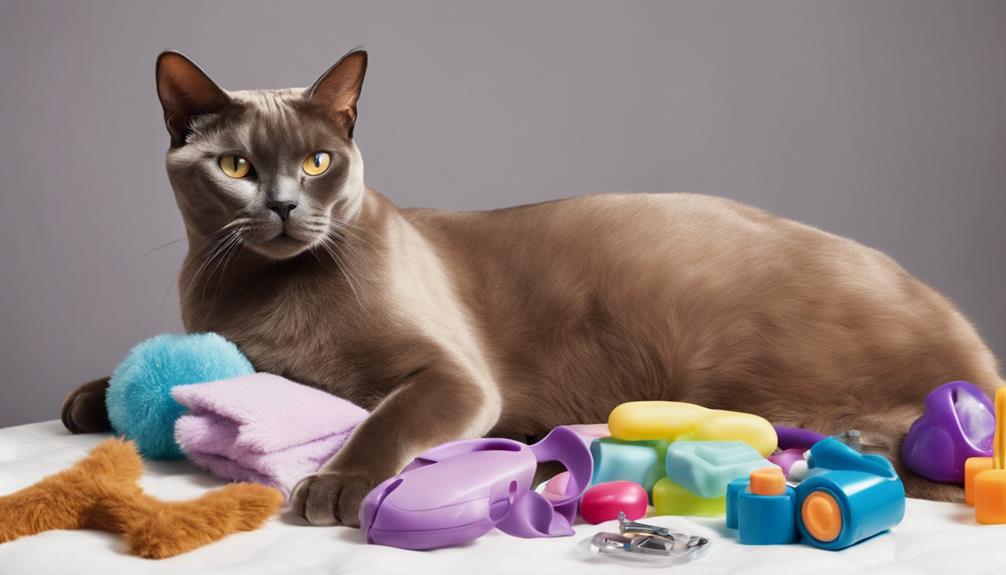
Maintaining a grooming routine is crucial for effectively caring for a hypoallergenic Burmese cat. Due to their low shedding and minimal dander production, Burmese cats are considered suitable for individuals with mild to moderate allergies. These feline friends produce lower amounts of allergenic proteins like Fel d1, earning them an 8/10 hypoallergenic score.
Regular grooming practices play a vital role in managing shedding and reducing allergen exposure in Burmese cats. While no cat breed is entirely hypoallergenic, Burmese cats are a great choice for allergy sufferers because of their low allergen production.
To ensure your hypoallergenic Burmese cat stays comfortable and allergy-friendly, make grooming a part of your routine. Brush their coat regularly to minimize shedding and dander. Bathing can also help reduce allergens on their fur. Additionally, keeping their living area clean and free of dust and allergens can further support their well-being.
Frequently Asked Questions
Are Burmese Cats Bad for Allergies?
For allergies, Burmese cats are a good choice. They shed less and produce less dander, reducing allergy risks. While not allergen-free, proper grooming can manage allergens. Living with a Burmese cat is usually comfortable for allergy sufferers.
What Is the Most Hypoallergenic Cat?
When looking for the most hypoallergenic cat, we consider breeds like the Sphynx, Cornish Rex, and Devon Rex due to their low shedding and dander production. Balinese cats are also known for being a great choice for allergy sufferers.
Are Burmese Cats Cuddly?
Oh, absolutely! Burmese cats are incredibly cuddly. They love being close to us, seeking attention and affection. Their affectionate nature and desire for physical contact make them wonderful companions who enjoy snuggling and being held.
Are Burmese Cats Low Maintenance?
We find caring for Burmese cats a breeze. Their short coat requires minimal effort, rating their grooming needs at 3/10. Regular brushing keeps shedding in check. They're self-groomers, reducing the need for baths.
Conclusion
In conclusion, while Burmese cats aren't completely hypoallergenic, their low shedding levels and manageable grooming needs make them a suitable option for some allergy sufferers.
By regularly grooming your Burmese cat and keeping your living space clean, you can help reduce allergens and enjoy the companionship of these affectionate felines.
So, if you're considering adding a Burmese cat to your family but have allergies, don't let that stop you from experiencing their playful and loving nature.
